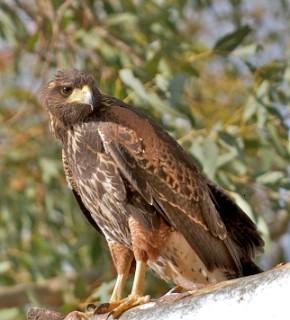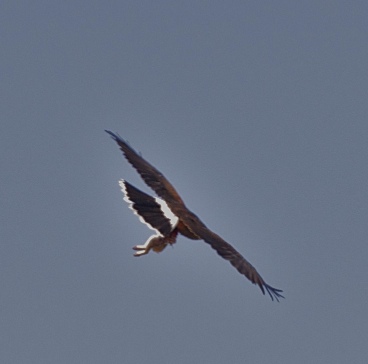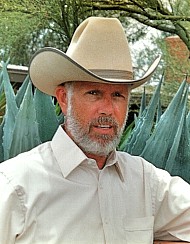
Harris' hawks
This is a juvenile Harris' hawk. The hawk has been out of the nest for about one week. It is standing on a limb in one of our courtyards. The fledgling is one of four birds that were hatched in a nest in one of our trees. As many of you know Josephine and I have several eucalyptus trees on our property in Tucson Arizona. One if the largest trees has a hawks nest in it. The tree is about 150 feet high, near the top hawks have built a nest. The nest is quite large, I would guess it is about 4 to 6 feet in diameter and approximately 6 inches deep. over the last 4 years the nest has produced a total of 17 hawk fledglings. All of the young birds have grown to be adults.
The first two nests produced 8 baby coopers hawks the third nest, 5 coopers and the 4th nest was 4 Harris hawks. This year. 2010 it is still uncertain whether or not the nest will be occupied or not. If there is a pair of hawks that use the nest we will soon start to see activity around the nest. That has not happened so far although we have seen a female coopers in the area several times.

As a result of being privileged to see the hawks up close over the years I have produced two books, the first was about a family of Coopers hawks and the second was on Harris hawks.
On the right we have an adult Harris hawk. This hawk's name is Henry. Henry is the father of the hawk shown above. The viewer can easily see the difference in coloration between the two hawks. The difference is most noticeable on the head, eye, beak, belly and chest. When young hawks first leave the nest they are usually as large or even larger than their parents this is because of the baby fat they accumulate while in the nest where they get very little exercise. As soon as they leave the nest and get more physical activity they quickly loose the extra fat and are about the size of their parents. That is why it is easier to identify the fledglings by their coloration.
It is usually more than a year before the youngsters get their adult coloration. The favorite food of Harris hawks is rodents such as ground squirrels, pack rats. kangaroo rats, antelope squirrels and just about anything that lives on the ground that they can lift aloft and carry it to their nest or perch. This includes rabbits, lizards and even snakes. It would be rare for a Harris hawk to take a bird. All hawks are carnivores. They are meat eaters.
 In the photo below left I was able to get Henry the father of the Harris hawk family with a jack rabbit he has captured and is taking it to the family of nestlings.
In the photo below left I was able to get Henry the father of the Harris hawk family with a jack rabbit he has captured and is taking it to the family of nestlings.
It is rather unusual for a female to lay four eggs and the pair of adults to successfully incubate and raise that many babies. Henry spent almost all his time during daylight hours hunting for food. I was not able to determine how much food the two adults and four nestlings consumed each day but I know is was a considerable amount.
To be able to write a commentary for a photo book it is necessary to have several hundred high quality photos to make the photos tell a story. I am sure I took several thousand photos to be able to make the story. This required me to take photos every day for several weeks then classify the photos so I could find them on my computer. Some of the days during this time the temperature climbed above one hundred degrees and on some days it would climb to 110 degrees.. In the end I felt it was worth the effort.
Harris hawks are a favorite bird that falconers use to train to use in their sport. The birds are exceptionally intelligent and are superb flyers. Peregrine Falcons are the absolute favorite bird because of the super flying skills and their speed. Peregrine Falcons use the technique of soaring higher than most birds fly then they will attack their prey by diving on the bird they are trying to capture from above. The falcon will take the prey on the wing. Harris hawks are beneficial in keeping ground squirrels and other varmints in check.
Cooper's hawks
The bird below is an adult female Coopers hawk In the book I wrote about Cooper's hawks this bird was
 Mrs. Coop. Coop and Mrs. Coop were the parents of 4 nestlings, the nestlings were JR, Molly, Geo, Jo and Felix. You will get a chance to meet them just a little later. My wife Josephine and I live in Tucson, Arizona. The property we live on is fairly close in with regard to the city however the house was built in the mid 60's and is constructed of masonry. When the houses in our area were built land was cheap compared to prices today so all of the houses are on a lot that is at least one acre in size. Many of the houses are on lots larger than the minimum. This means there is quite a lot of vacant space. The vacant space means there is an abundance of native plants, this in turn creates a habitat for many kinds of rodents, reptiles, insects and birds. It also provides places to hide and build nests and burrows. In other words a sanctuary within a city of approximately one million persons.
Mrs. Coop. Coop and Mrs. Coop were the parents of 4 nestlings, the nestlings were JR, Molly, Geo, Jo and Felix. You will get a chance to meet them just a little later. My wife Josephine and I live in Tucson, Arizona. The property we live on is fairly close in with regard to the city however the house was built in the mid 60's and is constructed of masonry. When the houses in our area were built land was cheap compared to prices today so all of the houses are on a lot that is at least one acre in size. Many of the houses are on lots larger than the minimum. This means there is quite a lot of vacant space. The vacant space means there is an abundance of native plants, this in turn creates a habitat for many kinds of rodents, reptiles, insects and birds. It also provides places to hide and build nests and burrows. In other words a sanctuary within a city of approximately one million persons.
Coopers hawks favorite food is doves. In our part of Arizona mourning doves are maybe the most plentiful of all birds therefore there is a plentiful amount of food available for the hawks. At one time these hawks were known as chicken hawks and because they prayed on a source of food for humans the hawks were hunted almost to extinction. However they are now protected and have recovered quite nicely. For those of you that have been lucky enough to have seen the birds in their natural habitat they are beautiful. Coopers hawks either take birds on the wing or setting in a tree they seldom take birds on the ground such as quail or pheasants. Most birds such as quail are herbivorous meaning they eat vegetation and seeds. And, some birds such as quail drink little or no water, they get their moisture from what they eat. At our home in Tucson we have a water fountain that runs all of the time we also have a stream that runs as well, I have never seen a quail drink from either water source in the 25 years we have lived on the property.
 Born 08/13/1925
Born 08/13/1925